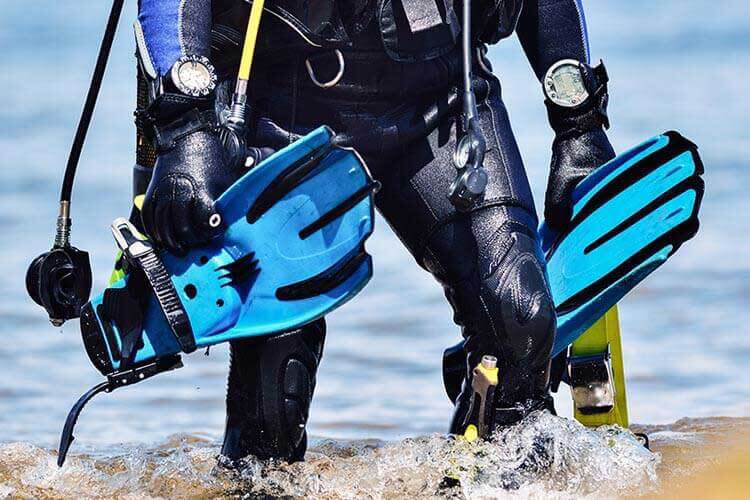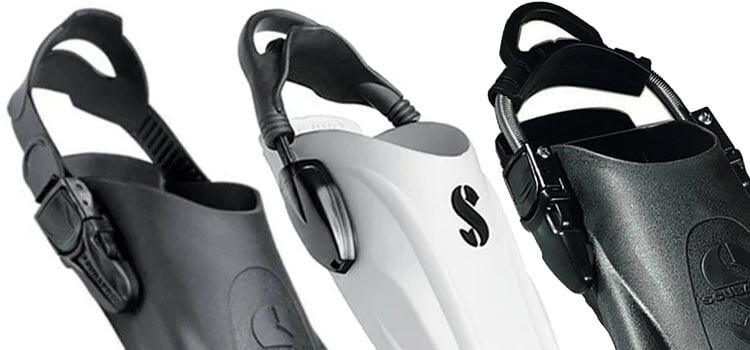
Like all dive gear, there are many different options when it comes to buying your first set of fins, but the decision boils down to some fairly simple questions
Like all wearable scuba diving gear, the most important feature of your first equipment purchase is that it fits correctly and comfortably.
A poorly-fitting set of fins will be uncomfortable, possibly blister-inducingly painful, and leave you struggling in current, when you need the power most.
Buying your first dive equipment series:
Full-foot fins or open-heel with dive boots?
The first question when it comes to buying fins for scuba diving is do you want full-foot fins, or open-heel fins with booties?
Personally, I recommend open-heel and booties every time – especially if you’re new to diving – because open-heel fins and boots work in all possible locations, whereas full-foot fins are limited to dive spots where you don’t have to walk over anything painful to bare feet, such as hot beaches, rocks, pebbles, shells, sea urchins, scorpionfish, splintered wooden decks, metal bolts and broken glass.
Open-heel fins and booties protect your feet from all of the above, plus offer a measure of exposure protection in cooler water. The adjustable (or spring-loaded) straps common to open-heel fins also help ensure a close fit regardless of the size and shape of your foot.
Full-foot fins have their uses; some people swear they get more power and ‘feel’ from the closer contact between foot and blade, but they are not suitable for all environments and, therefore, not the best option for a first-time purchase if you don’t know where your future dive career will take you.

Best fit is best for dive fins.
Like all wearable dive gear, fit is foremost. If your fins don’t fit they won’t generate the power you need and may be excruciatingly painful.
It’s important to try the fins on before buying, and it’s especially important that you try them on with dive boots, or at the very least, footwear of similarly-sized proportions.
By and large, open-heel fins are made to fit regular foot sizes, but not precisely so. For example – one manufacturer’s ‘Large’ size may fit a UK size 9-11, or a European 43-46, but the boots may add an extra size to the fitting, so it is important to check, especially if your natural foot size is somewhere near the margins.
Make sure the straps fit your booted feet, which is not as exact a science as it sounds. Some fins come with adjustable straps, others with elastic or spring straps. Elastic and spring straps are quicker for donning and doffing your fins, but may have less overall range to accommodate different sizes of foot and boot.
Adjustable straps may have more room for adjustment but the trade-off is that they are a bit more fiddly and may leave you with excess strap flapping around your ankles.
There’s no real overall winner except the one which fits and makes you feel most comfortable. Check in the shop. Wiggle your feet. Make sure.

Style or substance
I class fins as ‘Entry-level’, ‘Advanced’ and ‘Technical’, and for your first fin, entry-level is almost certainly the way to go. ‘Advanced’ fins – those with splits or bends or extra hydrodynamic power channels – do not always suit all styles of finning, and your style of finning is something that grows with you as you gain experience. ‘Technical’ fins are actually pretty basic, but they are often heavier and require more effort to utilise properly.
For your first dive equipment purchase, a comfortable, bog-standard set of paddle fins is the best choice. They suit all finning styles, which means you can work on developing a technique that suits you, and tend to have a lower price point. They are often used as rental gear by dive schools and will therefore have a measure of familiarity.
If you have the opportunity to try some different fin sizes before making your purchase then this would be ideal. It may well be that one of the more advanced or alternative designs suits you better, but if you’re not sure where to start then it’s better to plump for a basic style of fin rather than spend money on something that may not work for you.
More from DIVE’s equipment guides:
- Diver bitten while freeing entangled shark off Hawaii Island - 12 December 2025
- Camel Dive launches Red Sea storytelling contest for underwater creators - 11 December 2025
- Ancient Egyptian pleasure barge discovered in submerged harbour of Alexandria - 10 December 2025


